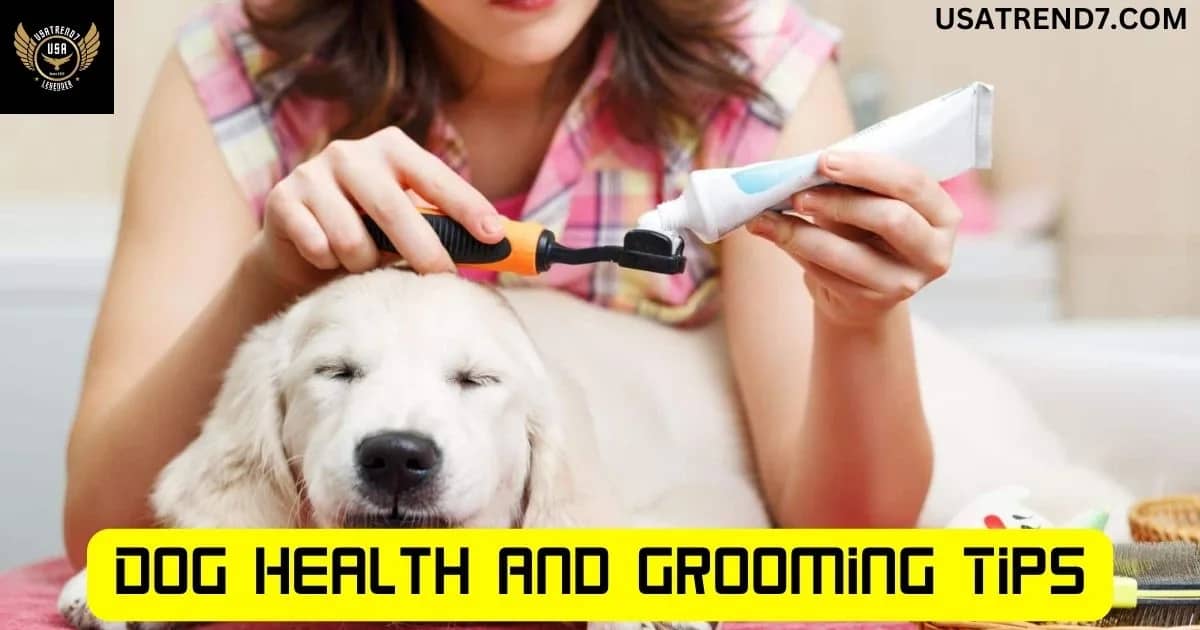Dog Health and Grooming Tips: How to Groom a Dog at Home, Take Care of Them, and Ensure Their Hygiene
Introduction: Dog Health and Grooming Tips Dogs are wonderful creatures that bring joy and love into our lives. As dog owners, it’s our responsibility to ensure that our furry friends are healthy, happy, and well-groomed. This article will provide you with dog health and grooming tips, including how to groom your dog at home, take care of them, and ensure their hygiene. By following these tips, you can ensure that your dog remains healthy and happy for years to come.

How to Groom a Dog at Home: (Dog Health and Grooming Tips)
Grooming your dog at home is an important part of their care routine. It helps keep their coat healthy and shiny, and it’s also an opportunity to bond with your dog. Here are some tips on how to groom a dog at home:
- Brush your dog’s coat regularly: Brushing your dog’s coat helps remove dirt and tangles, and it also distributes natural oils throughout their fur. Depending on your dog’s coat type, you may need to brush them daily or every few days.
- Bathe your dog when necessary: Dogs don’t need to be bathed as often as humans do. In fact, bathing them too frequently can strip their coat of natural oils. However, if your dog gets dirty or smelly, a bath is necessary. Use a dog-specific shampoo and avoid getting water in their ears.
- Trim their nails: Long nails can be uncomfortable for your dog and can even cause them pain. Trim their nails regularly using dog nail clippers, being careful not to cut the quick (the pink part of the nail that contains blood vessels).
- Clean their ears: Dogs’ ears can accumulate dirt and wax, which can lead to infections. Clean their ears with a dog-specific ear cleaner and a cotton ball, being careful not to insert anything into their ear canal.
- Brush their teeth: Dogs can get dental problems just like humans do. Brushing their teeth regularly can help prevent dental issues. Use a dog-specific toothbrush and toothpaste, and be sure to reward them with a treat afterward.
How to Take Care of a Dog at Home: (Dog Health and Grooming Tips)

In addition to grooming, there are other ways to take care of your dog at home to ensure their health and happiness. Here are some tips:
- Provide them with a balanced diet: Feeding your dog a balanced diet is crucial for their health. Choose a high-quality dog food that meets their nutritional needs and avoid feeding them table scraps or human food.
- Exercise your dog regularly: Exercise is important for your dog’s physical and mental health. Take them for walks, play fetch, or engage in other activities that they enjoy.
- Provide them with toys and mental stimulation: Dogs need mental stimulation just as much as they need physical exercise. Provide them with toys and games that challenge them mentally.
- Keep up with their vaccinations and check-ups: Regular veterinary check-ups and vaccinations are important for your dog’s health. Make sure to schedule regular appointments with your vet and keep up with their vaccinations.
Dog Hygiene Tips: (Dog Health and Grooming Tips)

Ensuring your dog’s hygiene is important for their health and happiness. Here are some hygiene tips for your dog:
- Clean up after your dog: Pick up your dog’s poop when you take them for a walk or let them outside. This helps keep your community clean and prevents the spread of disease.
- Keep their living space clean: Regularly clean your dog’s bed, toys, and living space to prevent the buildup of bacteria and other germs.
- Use flea and tick prevention: Fleas and ticks can cause a range of health issues for your dog, including skin irritation and even diseases. Use a flea and tick preventative recommended by your vet to keep them protected.
- Groom them regularly: As mentioned earlier, regular grooming helps keep your dog’s coat healthy and shiny, and also prevents skin issues.
Advanced Dog Grooming Techniques: (Dog Health and Grooming Tips)
If you want to take your dog grooming skills to the next level, here are some advanced techniques to try:
- Scissoring: Scissoring involves trimming your dog’s coat using scissors. This technique is often used to achieve a specific cut or style.
- Hand Stripping: Hand stripping is a technique used to remove dead hair from certain breeds of dogs with wiry coats. This technique is done by hand, rather than using clippers.
- Creative grooming: Creative grooming involves using dye, stencils, and other tools to create unique designs on your dog’s coat. While this is a fun and creative way to groom your dog, it’s important to ensure that the products used are safe for your dog’s skin and coat.
Dog Grooming Kit: (Dog Health and Grooming Tips)
To properly groom your dog at home, you’ll need a few essential tools. Here are some items you should have in your dog grooming kit:
- Brushes and combs: Depending on your dog’s coat type, you may need different types of brushes and combs. Some common options include slicker brushes, pin brushes, and undercoat rakes.
- Dog-specific shampoo: Human shampoo can be too harsh for your dog’s skin and coat. Use a shampoo specifically designed for dogs.
- Nail clippers: Clippers specifically designed for dogs are recommended, as they’re less likely to cause injury.
- Ear cleaner: Use a dog-specific ear cleaner to keep your dog’s ears clean and prevent infections.
Conclusion: Grooming your dog at home and ensuring their health and hygiene can seem daunting, but it’s an essential part of being a responsible dog owner. By following these dog health and grooming tips, you can ensure that your furry friend stays happy and healthy. Remember to always consult with your veterinarian if you have any concerns about your dog’s health. With a little love and care, your dog will thrive and bring joy to your life for years to come.
FAQ:- (Dog Health and Grooming Tips)
- How often should I groom my dog?
The frequency of grooming your dog will depend on their coat type and length. As a general rule of thumb, dogs with long hair should be groomed at least once a week, while dogs with short hair can be groomed every few weeks.
- How do I groom my dog at home?
To groom your dog at home, you’ll need a few essential tools like brushes, clippers, and dog-specific shampoo. Start by brushing your dog’s coat to remove any tangles or mats, and then move onto bathing, clipping their nails, and cleaning their ears.
- What are some tips for maintaining my dog’s oral hygiene?
Regular dental care is important for your dog’s overall health. Brush their teeth with a dog-specific toothpaste, offer dental chews, and schedule regular dental check-ups with your veterinarian.
- How can I prevent my dog from getting fleas and ticks?
Fleas and ticks can be prevented with a variety of products including collars, topical treatments, and oral medications. Consult with your veterinarian to determine which product is best for your dog.
- Can I use human shampoo on my dog?
It’s not recommended to use human shampoo on your dog as the pH level of their skin is different than ours. Use a dog-specific shampoo to avoid skin irritation and damage to their coat.
- How often should I take my dog to the veterinarian?
It’s recommended to take your dog to the veterinarian at least once a year for a check-up and vaccinations. However, if your dog is showing any signs of illness or discomfort, schedule a visit with your veterinarian as soon as possible.
- What are some signs of a healthy dog?
A healthy dog should have clear eyes, clean ears, a shiny coat, and be alert and energetic. Regular exercise, proper nutrition, and dental care are also important factors in maintaining your dog’s overall health.
- Can I groom my dog myself or should I take them to a professional groomer?
It’s possible to groom your dog yourself, but it’s important to have the right tools and knowledge to avoid causing any harm or discomfort to your dog. If you’re not confident in your grooming skills, consider taking your dog to a professional groomer.
you should also read this:- Dog Food Aggression/ How to Fix Dog Food Aggression

